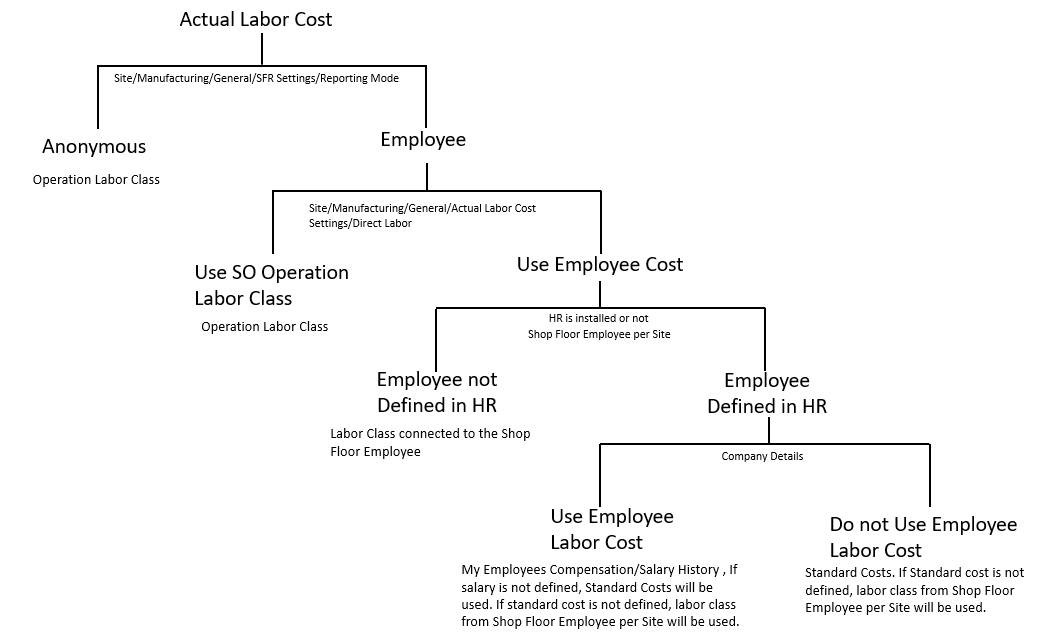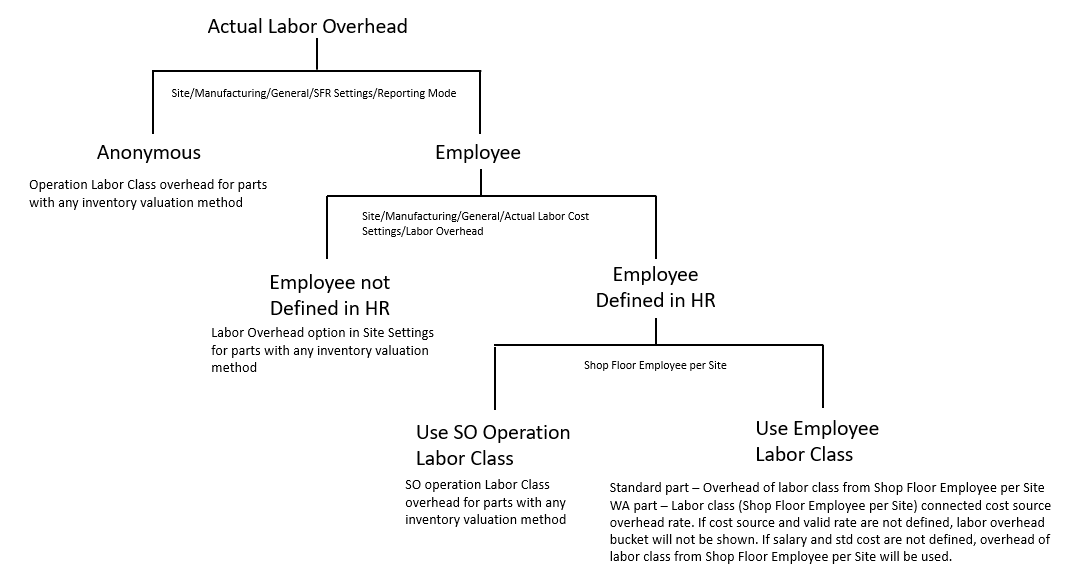Cost for Shop Order Labor Reports
The cost for labor time reported against a shop order operation can be fetched from different sources depending on the system configuration. The cost for labor setup and runtime is based on the reported man hours and setup man hours. More details about the calculation of man hours can be found in About Cost for Shop Floor Reporting
Labor Rate
To determine the hourly rate for a labor report the system uses the below logic:
This logic is valid for parts having any inventory valuation method. Cost Detection Message under Cost section in Labor History/General tab will give more information from where cost is fetched.
- If the labor time is not reported against a specific Employee ID the labor rate is fetched from the Labor Class Rate field in the Manufacturing Labor Class/Cost for the labor class to which the operation is connected.
- If the labor time is reported against a specific Employee ID and the Direct Labor in Actual Cost Labor Settings is set to Use Shop Order Operation Labor Class in Site/Manufacturing/General tab, the labor rate is fetched from the Labor Class Rate field in the Manufacturing Labor Class/Cost for the labor class to which the operation is connected.
- If the labor time is reported against a specific Employee ID, and the Direct Labor in Actual Labor Cost Settings is set to Use Employee Cost, and the employee is not defined in IFS/Human Resources, the labor rate is fetched from the Labor Class Rate field in the Manufacturing Labor Class/Cost for the primary site and labor class to which the employee is connected.
- If the labor time is reported against a specific Employee ID, and the Direct Labor in Actual Labor Cost Settings is set to Use Employee Cost and the employee is defined in IFS/Human Resources and the Use Employee Labor Cost option in Company Details page is enabled, the labor rate is fetched from the Amount column in Salary Historysection in My Employees Information/Compensations page. note that the logged on user must be linked to a person with HR access setup allowing the person to access the salary information for the reporting employees. If salary is not defined, the labor rate is fetched from the Standard Cost column in Standard Costs page. If standard cost is also not defined, the labor rate is fetched from the labor class connected to Shop Floor Employee per Site page.
- If the labor time is reported against a specific Employee ID, and the Direct labor in Actual Labor Cost Settings is set to Use Employee Cost and the employee is defined in IFS/Human Resources and the Use Employee Labor Cost option in Company Details page is not enabled, the labor rate is fetched from the Standard Cost column in Standard Costs page. If standard cost is not defined, the labor rate is fetched from the labor class connected to Shop Floor Employee per Site page.

Labor Overhead
To determine the overhead rate for a labor report the system uses the below logic:
If layered overheads are defined in the Manufacturing Labor Class, which is used to fetch overheads, those layered overheads will be shown in the transactions. Cost Detection Message under Cost section in Labor History/General tab will give more information from where cost is fetched.
- If the labor time is not reported against a specific Employee ID the labor overhead is fetched from the Overhead field in the Manufacturing Labor Class/Cost for the labor class to which the operation is connected. This is valid for parts having any inventory valuation method.
- If the labor time is reported against a specific Employee ID and the employee is not defined in HR, the labor rate is fetched from the Overhead field in the Manufacturing Labor Class/Cost according to the Labor Overhead option in Actual Labor Cost Settings in Site/Manufacturing/General tab. This is valid for parts having any inventory valuation method.
- If the labor time is reported against a specific Employee ID and the employee is defined in HR, and the Labor Overhead in Actual Labor Cost Settings is set to Use Shop Order Operation Labor Class in Site/Manufacturing/General tab, the overhead rate will be fetched from the Overhead field in the Manufacturing Labor Class/Cost to which the shop order operation is connected. This is valid for parts having any inventory valuation method.
- If the labor time is reported against a specific Employee ID and the employee is defined in HR, and the Labor Overhead in Actual Labor Cost Settings is set to Use Employee Labor Class in Site/Manufacturing/General tab and Cost Valuation Method list in the Inventory Part page for the manufactured part is set to Standard Cost, the overhead rate will be fetched from the Overhead field in the Manufacturing Labor Class/Cost for the primary site and labor class to which the employee is connected.
- If the labor time is reported against a specific Employee ID and the employee is defined in HR, and the Labor
Overhead in Actual Labor Cost Settings is set to Use Employee Labor Class in
Site/Manufacturing/General tab and the Cost Valuation
Method list in the Inventory Part page for the manufactured
part is not set to Standard Cost, the overhead rate will be fetched from the cost source
connected to the primary labor class in Manufacturing Labor Class/Cost Sources.
To define an overhead rate for a cost source; first create a cost source in the Cost Sources page and specify the desired overhead rate in the list in list of the cost source. Select a Cost Source Indicator for Shop Order - Employee Labor Overhead in the Cost Source Indicator Definitions page, then connect the selected cost source indicator to the cost source in the Cost Source Indicators page.
